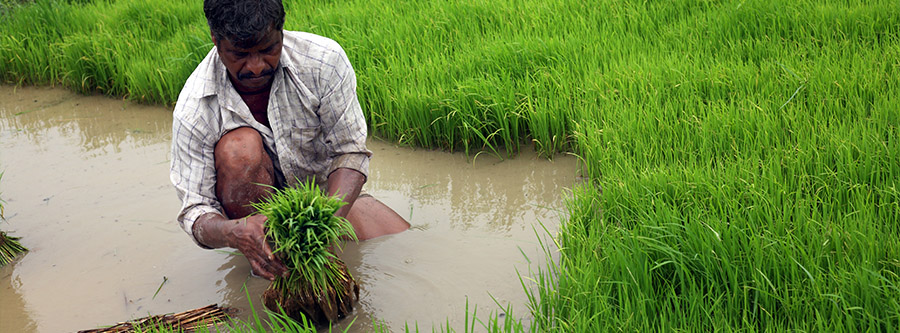Catalyzing Change in South Asia’s Rice-Based Systems

The Cereal Systems Initiative for South Asia (CSISA) operates in areas with high concentrations of rural poverty, in the Eastern Indo Gangetic Plans of Bangladesh, India and Nepal, where smallholder farmers are most vulnerable to the risks of increasingly erratic weather patterns. It is pertinent to note that the productivity of rice-based systems in these locations continue to be marred by a vast array of issues including, but not limited to, various biotic and abiotic stresses, irregular rains, outdated agronomic techniques, limited infrastructure, poor weed management practices, a lack of quality inputs and their timely availability.
Sub-par market infrastructure development and extension services coupled with a landscape dominated by resource-poor, smallholder farmers have so far prevented large scale adoption of mechanization and access to new knowledge, technologies and quality seed. Since there is virtually no scope for expanding the area under agriculture, as yield gaps close, future advances in production must come from systems intensification – growing more crops per year. A recent CSISA study, for example, indicates substantial scope for surface water irrigation to intensify cropping on fallow and rainfed cropped land in Southern Bangladesh.
Improved and easy to implement weed management is also a crucial strategy to facilitate sustainable intensification transitions in rice especially for technologies such as dry direct seeded rice (DSR), with average yield gaps due to farmers’ current practices in Bangladesh estimated at 1 ton per hectare. Studies in the northwest region of the country show that private dealers dominate the input channels in villages with a share of 96 percent of the fertilizer and pesticide markets. CSISA will utilize such input dealer networks to disseminate simple and actionable guides as well as provide experiential training to the dealers and retailers.
In India, where farmers’ use of recommendations from agro-advisory systems remains limited, CSISA is leveraging crop modeling and remote sensing informatics to improve the quality of irrigation scheduling recommendations for rice. Using geoinformatics, CSISA has also been able to more accurately gauge local farmers’ needs and respond accordingly. For example, in Odisha, it enabled the identification of districts most prone to flooding and hence ill-suited for DSR. Farmers in those areas are encouraged to use mechanical transplanting, which can substantially increase profitability in the double-rice systems prevalent in Odisha and which is beneficial for subsequent crops.
CSISA Impacts over the Years - Sales of hybrid rice in Bihar increased by 500 tons in 2015 over 2014, with an estimated area expansion of 33,000 hectares. - The number of CSISA-supported farmers practicing mechanical transplanting of rice in Odisha increased from 40 in 2013 to 2,000 in 2015. - In Bangladesh, more than 900 mechanical rice seeders have been sold by private sector partners since October, 2015 - In Bangladesh, between 2010 and 2015, more than a million farmers benefitted from rice varieties with abiotic stress tolerance (salinity, flooding and drought) or high yield potential distributed CSISA. - Out of 60 rice entries tested by CSISA in India during the 2014 dry season under machine sown dry direct-seeded rice, 15 entries recorded more than 7.5 tons per hectare.
Across the three countries, CSISA’s interventions are grouped into three thematic areas: innovation towards impact – reducing risk for intensification and adding value to extension systems; systemic change towards impact – building partnerships and scaling pathways, and; achieving critical impact at scale – mainstreaming innovations by creating a critical mass of early adopters. Under each of these themes, CSISA conducts business diagnostics, trainings and mentoring to service providers, develops and disseminates communications material on better-bet agronomy, and conducts on-farm verification trials of production practices to reduce risk and ensure reliable rice production. Additionally, the project will employ a ‘training of trainers’ model to build capacity of NARES partners, NGOs and women’s self-help groups and their federations to ensure interventions are replicated beyond the project lifecycle. Altogether, these interventions will not only help increase yields and profitability of rice farming in South Asia, but also create business opportunities for women and youth in agriculture.
Enabling Environment
CSISA’s policy interventions prioritize scaling up work with national partners to address policy constraints in target geographies. Planned activities on seed systems and markets will focus on communicating policy reform options for state-led seed market interventions and the tradeoffs between promoting short-term varietal replacement and long-term seed market development. While activities on scale-appropriate mechanization will emphasize the design of policy incentives and investment strategies, such as targeted subsidies, which encourage the development of necessary localized commercial markets. Lastly, CSISA will support policy reforms to promote balanced fertilizer use through improved understanding of the costs, benefits, fiscal burdens, sustainability and effectiveness of various public programs.
Over the past years 7 years, CSISA has forged strong partnerships including with the Bangladesh Agricultural Research Council, Indian Council for Agricultural Research, Nepal Agricultural Research Council and state agriculture universities. These partnerships continue to advance research-based recommendations for basic rice agronomy and application of precision approaches to weed, water and nutrient management, including decision frameworks for intensification.
Priority Interventions for Kharif 2016 1. Integrated weed management to facilitate sustainable intensification transitions in rice 2. Building precision nutrient management approaches around established and emerging scaling pathways 3. Deployment of better-bet agronomic messaging through input dealer networks and development partners 4. Promoting direct dry-seeded rice sowing to address labor and energy constraints to precision rice establishment 5. Production and use of healthy rice seedlings through training of individual farmers, farmer groups, service providers and nursery enterprises; engagement with partners to take this to scale 6. Rice fallows development in coastal Bangladesh and the state of Odisha in India 7. Providing timely and actionable advice on yield-enhancing irrigation scheduling for rice 8. Increasing the capacity of NARES to conduct participatory science and technology evaluations in Bangladesh and India.
This article is authored by Sudhanshu Singh, IRRI Senior Scientist and Rainfed Lowland Agronomist, South Asia.
Tags: Kharif 2016
